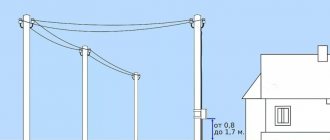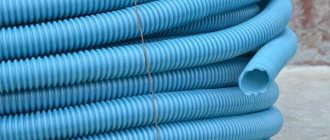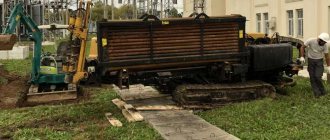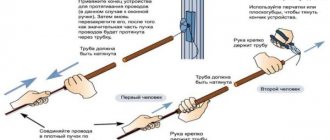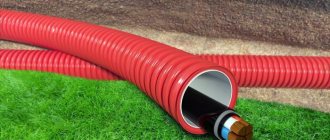Underground cable laying is becoming increasingly popular, including when it comes to communications for private homes. This method allows you to protect wires from breaks caused by strong gusts of wind, snow falling from roofs, and branches of trees growing on the site. But it also has its drawbacks associated with soil pressure, exposure to groundwater and other harmful factors. However, a special pipe for laying cables in the ground almost completely eliminates them, taking on all the harmful load.
Aerial cable laying increases the risk of cable breakage Source repair-pavlovsky-posad.rf
Justifications for underground installation of wire communications
Initially, underground cable installation requires higher costs than overhead installation. But in the end, the operation of such communications requires virtually no costs. They are not affected by such natural factors as strong winds, snowfalls, icing, they are more difficult to damage mechanically, they are protected from vandalism and theft.
In the event of damage, restoring and repairing overhead lines requires a lot of money and time, and a long absence of electricity and communications in the house causes related problems and inconveniences.
The section from the main pole to the house is always the most dangerous, as it is often broken off by snow falling from the roof and damaged by branches of fruit trees growing on the site. This is what they most often try to lay underground. Using the same method, it is best to pull the cable from the house to the bathhouse, garage and other outbuildings, so as not to install extra poles on the site.
Scheme of laying a cable in a trench from a pole to a house Source dom-expert.by
In addition to electrical cables, a modern house comes with many cables - telephone, control, computer, television. In order not to entangle it with wires, they can all be brought inside, combined into one bundle, and a pipe or corrugation for laying the cable in the ground will protect it from stray currents, groundwater, rodents and various damages.
Important nuances of grounding
Protective grounding performs a safety function in the event of human contact with electric current.
Its impact is manifested as follows:
- at 0.6-1.5 thousand µA the effect of electricity on the human body is felt;
- at 2-4 thousand μA, fingers tremble;
- at 5-7 thousand μA, the hands cramp;
- at 10-15 thousand µA without outside help it is almost impossible to release the hand with the conductor;
- at 20-25 thousand μA, severe pain appears, breathing is difficult, and it is impossible to take your hands off the wire;
- at 50-80 thousand μA, paralysis of the respiratory system occurs, and disruptions in the functioning of the heart are observed.
Types of pipes used
In previous years, underground installation was carried out using steel and asbestos cement pipes. Now they have added products made from different types of plastic:
- polyvinyl chloride;
- polypropylene;
- high pressure polyethylene;
- low density polyethylene.
The use of each type is regulated by regulatory documents - GOST and SNiP. For example, only a control cable is allowed to be laid underground in a steel casing, since the power cable with such installation has no protection in the event of a breakdown.
Steel pipes today are used for wiring inside buildings Source wirings-diagram.com
Asbestos-cement pipes are almost never used these days due to their fragility and heavy weight; the use of steel pipes, which are quite expensive and subject to corrosion in a humid environment, is also limited. They were replaced by plastic, the material is lightweight, durable, non-corrosive, and has excellent dielectric properties. Plastic pipes can have different cross-sections, wall thicknesses, be smooth or corrugated, single- or double-layer.
Floor cable channels
Floor cable channels are designed to protect cables on the floor. These electrical installation measures are provided in cases where it is impossible to distribute the wires on the walls and it remains to lay the wire along the floor surface, for example through a threshold.
Floor channel for wires on the threshold
Since floor electrical ducts are installed in residential and administrative premises literally underfoot, they must withstand a large load - the weight of a person’s body or carts, so these ducts are made of metal or very hard plastic.
Metal channel housing on the floor
The goal of floor ducts is to be as invisible and low as possible, which is why gray or a wood-imitating color is used for their body. You can also purchase floor channels whose color exactly matches the color of the parquet or linoleum installed in the apartment.
The decoration imitates the channel in accordance with the floor color
Floor channels also use installation accessories, and the technology for attaching them to the floor surface does not differ from fixing the previously described methods of attaching skirting boards.
Attention! Due to the fact that moisture and condensation can collect inside all ducts, they are only suitable for installation in a dry environment. Information about the suitability of a given channel according to the IP index of its security class is marked on the housing. Most often this is IP 20. Naturally, there are also special types of cable channels, but in 99% of cases these are the ones used.
Products made from low-density polyethylene
The most obvious popularity is the HDPE pipe for laying cables in the ground; it is divided into two main types:
- technical – general purpose;
- electrical – designed specifically for the installation of underground cable ducts.
Technical
Power transmission lines and other utility networks can be laid in different pipes. Technical pipes that have smooth single-layer walls and are painted black are also quite suitable for these purposes. They have all the necessary characteristics: resistance to aggressive chemicals, mechanical strength, electrical insulating properties.
Technical single-layer pipes Source yahplastic.com.pk
Since such products have a universal purpose, they are not equipped with devices for tightening the cable.
Smooth single-wall polyethylene pipes are rigid and flexible. Laying HDPE pipes in the ground is permitted only in a rigid version, as is pouring the cable into a concrete floor screed or laying it in brickwork. Flexible tubes are used to protect electrical wiring inside the house.
See also: Catalog of companies that specialize in electrical work of any complexity
Electrical
Double-wall pipes are more suitable for underground networks. They can accommodate power lines with AC or DC voltages up to 1000 V.
Double-wall pipes are produced smooth and corrugated, their outer shell is made of HDPE, and the smooth inner shell is made of another type of PE - high-density polyethylene. The most durable and reliable products are those with corrugated outer walls, which are reinforced with thin steel wire.
Double-wall corrugated pipes Source twimg.com
Laying a cable in the ground in a HDPE pipe of this type is characterized by maximum simplicity and speed of installation due to smooth internal walls that do not create obstacles for its pulling. And the outer corrugated shell has excellent ring rigidity and does not wrinkle or break under the weight of a thick layer of soil. At the same time, corrugated pipes have a low dead weight, which also facilitates transportation, placement in trenches and assembly.
The features of the material, which retains strength and elasticity at any temperature, resistance to chemically aggressive environments and ultraviolet sunlight, do not create problems during storage and allow installation both in the summer heat and in the winter cold.
Cable wiring
In metal garages, sheds, greenhouses (in the individual residential sector), attaching conventional wiring to supporting structures is difficult and cable wiring can be used for this purpose. It is carried out, as a rule, with ordinary installation aluminum wires with polyvinyl chloride, polyethylene or rubber insulation or special cable wires. Cable wiring contains two main elements: a supporting cable with a set of tensioning devices and the electrical wiring itself with wires, mounting hangers, junction (branch) boxes, fittings and start-protective devices. For end fastening of steel cables, anchors or through bolts are used, which are installed in holes punched in the wall and secured by soldering from the outside, and for removal, a wide washer is placed under the nut. To connect the cable to the anchors, loops are made at its ends. If a steel rope is used as a cable, the loops are made using cable clamp 2 (Fig. 6) and coat 3, and in the case of using rolled wire - steel clip 5 (previously put on the wire rod and then welded) and clamp 6. Tension and boom the sag is adjusted by tension coupling 7, installed at both or one end of the cable. In addition to fastening at the ends, depending on the weight of the mounted electrical wiring and lamps, intermediate cable fastenings are installed to the ceiling structures as necessary, thereby reducing the sag and giving the entire line the necessary mechanical strength. End structures with insulators are installed at both ends of the cable.
Rice. 6. Elements of cable wiring 1 – cable; 2 – cable clamp; 3 – coat; 4 – wire; 5 – clip; 6 – clamp; 7 – tension coupling; 8 – final design
Brackets are installed at the locations of the lamps (Fig. 7) and lighting fixtures are attached to them.
Fig. 7. Brackets for fastening lamps (dimensions in mm): A - KPC swivel bracket; b- rotary bracket KPT; c — rotating bracket KPSh; g - wall bracket; 1 — rack 2 — console; 3 - holder; 4 - pipe; 5 - hook; 6 – emphasis
The connection of the taps to the lighting fixtures with the main line and the junction of the wiring with the supply lines is carried out using branch clamps in a plastic case and branch boxes having anchor devices for securing the boxes to the cable. Metal branch boxes at the places where wires enter must have split bushings made of insulating material, or additional insulation is applied to the wire.
Attic electrical wiring has its own characteristics. In houses with combustible floors, attic wiring, both open and hidden, can be carried out using wires and cables with aluminum conductors. In houses with fireproof floors, wires with aluminum conductors are laid openly in steel pipes or hidden in fireproof walls and ceilings. In houses with combustible floors, wires with aluminum conductors are laid openly in steel pipes, protecting them and junction boxes from dust penetration. In this case, it is allowed to use steel water-gas and thin-walled furnace-welded and electric-welded pipes with deburring.
Aluminum wires must be connected by welding, crimping or using clamps designed to connect aluminum wires. Connecting aluminum wires by twisting is allowed using a protective coating of technical petroleum jelly with periodic maintenance.
PROCEDURE FOR CONNECTING AN INDIVIDUAL HOUSE TO A POWER SUPPLY SOURCE
The natural desire of many people to move away from standard solutions has given impetus to the widespread development of individual construction of residential buildings, cottages, and garden houses. During individual construction, the issue of energy supply to the house inevitably arises.
The electrical circuit of a residential building or apartment is the natural end stage of a single energy system complex, and it is subject to all rules in force in the field of energy. This is dictated by the need to ensure the safety of residents. The type of power supply depends on what devices and equipment will be used. If all current collectors are single-phase (lighting, household appliances: refrigerator, TV, etc.), then the line approaching the house will be identical. And if it is necessary to connect three-phase equipment (lathe, circular saw, etc.), a 380 V power line should be installed, consisting of three wires corresponding to each phase and a fourth, neutral wire. A three-phase line is much more expensive than a single-phase line, so you should refrain from laying it unless absolutely necessary. Before starting design work, it is necessary to obtain technical conditions for the energy supply of your home, for which you need to contact the energy supply organization (RES), with which the design documentation should be agreed upon. Compliance with technical conditions, as well as the Rules for the operation of electrical installations during installation work, is mandatory for each electricity consumer. This will avoid misunderstandings that may arise when obtaining permission to connect the house to the electrical network. In order to improve the aesthetic appearance of the house, as well as for greater reliability of power supply, it is preferable to provide an underground cable connection to the house from the electrical network. After completing all installation work, to obtain permission to connect, you must invite an energy inspector, who must present the following documentation:
1) Energy supply project agreed with the energy supply organization; 2) Protocols for checking cable insulation; 3) Acts on hidden work and grounding devices; 4) Protocols for measuring the resistance of the “phase-zero” loop; 5) Protocols for measuring ground resistance; 6) Technical passports for the electric meter and power equipment; 7) Certificate from RES on compliance with technical conditions.
The listed documentation can only be compiled by organizations or people who have the appropriate right.
The energy supervision inspector (controller) must check the electrical wiring for compliance with its Rules, the correct connection of the electric meter, the serviceability of the protective fuses and the automatic device, seal the meter, give permission to connect to the electrical network, as well as draw up a subscription book and conduct the necessary instructions.
Video description
Confirmation of how durable a corrugated pipe is is this video:
Installation features
The electrical HDPE pipe for cables in the ground has design features that distinguish it from general purpose pipes.
- For a quick, reliable and tight connection, they are equipped with special couplings without sockets.
- To pull the cable through the pipe, the products are equipped with special probes in the form of steel wire.
Couplings for joining pipe sections Source elnow.ru
Punching work
Open electrical wiring is carried out following completed construction work and does not require special grooves for laying wires. Sockets and switches of such wiring are attached to specially fixed wooden socket boxes. Therefore, for open wiring, punching work comes down to punching holes for installing bushings through walls and partitions, as well as drilling holes for installing plastic dowels for installing socket boxes. The holes for the bushings through the walls are made using a bolt. The bolt is pressed with a notch to the plane of the wall and, hitting the bolt with a hammer, small turning movements are made with the left hand.
Hidden wiring is usually carried out before plastering work, but if necessary, wiring can be laid in special grooves made in the plaster. In residential buildings, plaster is made from lime mortar, the hardness of which is low. Therefore, grooves in the plaster can be easily made with a chisel, chisel or even a large screwdriver. For large volumes, this work must be performed with a special electric or pneumatic cutter. The depth of the grooves should be the entire thickness of the plaster, because hidden wiring is carried out under the plaster, and not inside it. For boxes for sockets and switches, the recesses are made using a chisel and hammer. In this case, the depth of their placement should be such that the lid with its inner plane fits tightly to the plane of the plaster.
Selection of pipes according to technical characteristics
The greater the depth to which the cable corrugation is laid in the ground, the greater the mechanical strength it should have. Strength depends not only on the thickness of the walls, but on their ratio to the diameter of the pipe. It is determined by dividing the outer diameter by the wall thickness and is indicated by the SDR indicator: the lower it is, the higher the reliability of the product.
Table for determining SDR Source moikolodets.ru
Laying cables under the road
The laying of cables under the road in pipes is carried out with the permission of the organization on whose balance sheet the road is located. This point is especially relevant for routes located in populated areas, since other communications may pass under them. If laying under the road is carried out in a holiday village, then such an event must be agreed upon with the administration.
The rules for installing a power line in a protective casing under an unpaved road surface are the same as for conventional installation. The depth, arrangement of the sand cushion, backfill and other parameters coincide with the usual installation of communications. The electrical cable is laid in a pipe under a paved road, usually using the puncture method. Puncture involves the use of special equipment and is a trenchless method of arranging communications, however, the cost of such work is quite high.
Advantages of polyethylene pipes over steel pipes
A much lower price is an important, but not the most important advantage of plastic products compared to metal ones. A polyethylene pipe for underground cables has other advantages.
- Long service life.
For reference! The minimum warranty period specified by manufacturers is 50 years. But with high-quality installation and operation under normal conditions, it can turn out to be much more.
- Easy installation, the ability to connect small cross-section pipes without welding.
- Possibility of laying routes with bends without unnecessary fittings.
Laying along a curved path Source elektroas.ru
- Light weight.
- Strength at any temperature.
- Resistant to corrosion and rotting due to moisture.
- Excellent electrical insulating properties, allowing you to do without grounding.
- Safety against short circuits - the plastic shell stops combustion.
- Environmental safety - polyethylene does not decompose in the ground and does not emit toxic substances.
Safety requirements
By laying the cable in a metal pipe, it is possible to ensure fire safety and protect the cable itself. But one more problem remains - electrical safety. The metal conducts current; when a bare wire comes into contact with the pipe wall, there is a danger of a person receiving an electric shock, heating up the protective casing, and igniting nearby objects.
It is not enough to simply hide the electrical cable - so that the electrical network does not cause a tragedy, certain requirements must be observed:
- Cables with a triple braid are laid in a metal pipe - even if one layer of braid is damaged during pulling, there will be no contact between the wire and the metal.
- If the voltage in the cable is above 42 V, the casing must be grounded. This will protect against electric shock when touching a pipe that has come into contact with an electrical wire.
- Moisture must not get inside the pipe, as this will lead to corrosion of the casing and destruction of the wire braid. Therefore, the pipe system must be sealed and connections must be reliable.
- If the casing material is susceptible to corrosion, it should be coated with metal paint - this will extend the service life and prevent depressurization of the system.
- The distance from the pipe with the cable to the heating pipe must be at least 20 cm. Near sources of high temperature or open fire, the casing of the electrical cable must be covered with a heat shield - a curved steel plate that will reflect part of the heat.
Briefly about the main thing
When thinking about electrifying a country house and outbuildings, it is worth considering the option of underground cable laying, as the most reliable, safe and durable. To ensure that communications are not exposed to the harmful effects of moisture, do not experience soil pressure, and are not accidentally damaged when digging the site, they are placed in a durable casing made of pipes. Today, HDPE pipes are considered the best, having excellent technical characteristics corresponding to operating conditions. The most critical lines are best laid in double-wall corrugated pipes.
How to lay cable channels from electrical PVC pipes
Please note that if the main purpose of a PVC cable duct is to protect it from mechanical damage, then it can be made leak-proof. But you can protect the cables from dust, dirt and other external factors by assembling a moisture- and dust-proof pipeline.
If you plan to install non-flammable pipes for electrical wiring that will run near the heating system, they should be placed below the heating elements so that the cables do not heat up.
We draw your attention to the situation when in some places the heating pipes and the cable duct will intersect. In this case, the distance between them must be at least 5 cm. If the wiring is laid parallel to the heating pipes, the gap between them and the wiring must be at least 10 cm.
If you need to connect sections of electrical cable, it cannot be done inside the pipe. Boxes are usually installed at the junction points.
If the wiring is installed in a relatively dry room, then the connection of corrugated PVC pipes can be made without the use of a sealant. But if the microclimate in the building is quite damp, then sealing gaskets at the pipe connections are mandatory.
Please note that fittings and couplings are the optimal and most common methods of sealing connections.
